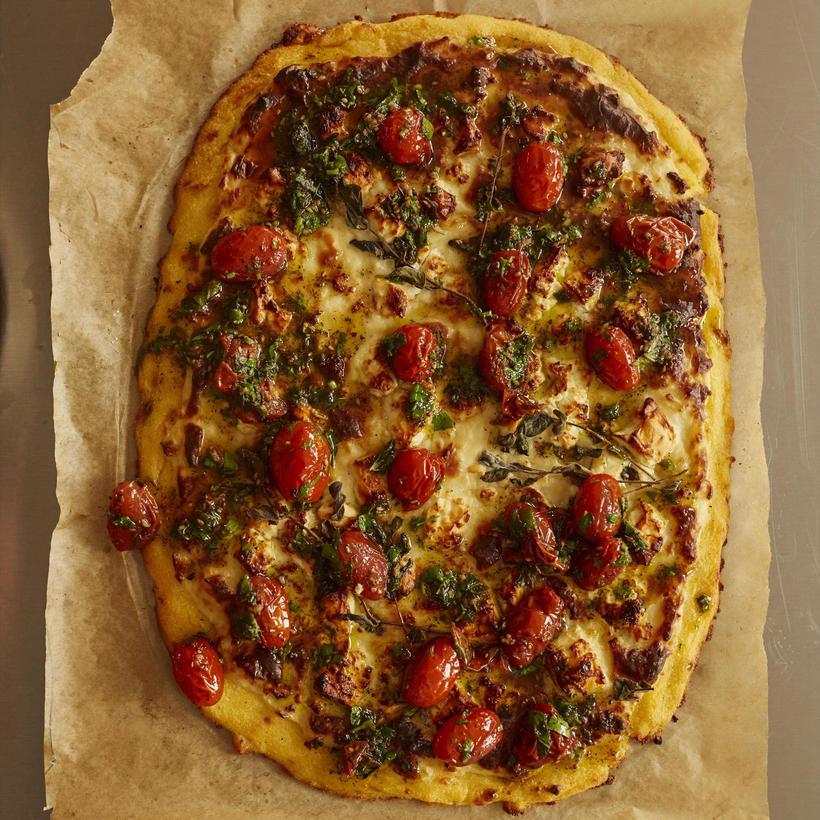As we sit down to chat in his light and airy test kitchen, Yotam Ottolenghi offers a plate of freshly baked cheddar and pistachio biscuits, still warm from the oven. As you might expect, they are delicious. The initial strong cheesiness is quickly overtaken by a detonation of pistachio.
The biscuits have been popular in Ottolenghi’s delis since he opened his first 20 years ago. “A constant, right from the beginning. Then recently they started giving us trouble,” he says. He is smiling now because a week of hard work seems to have solved the problem. But it was, he says, “a crisis”.
Pistachios, like za’atar and preserved lemons, are ingredients that have become closely associated with Ottolenghi, the chef who has done more than any other to change our relationship with Middle Eastern cooking over the past two decades. Pistachios have a particular place in his heart because he used to gorge on those that grew on a tree next to his childhood home in Jerusalem.
The problem with the biscuits was that they recently started turning out too soft and no one knew if it was an issue with the ingredients, where they were stored or the equipment used to make them. “Sometimes really weird things happen,” he says.
Pistachios, like za’atar and preserved lemons, are ingredients that have become closely associated with Ottolenghi.
Verena Lochmuller, the kitchen’s baking whiz who spearheaded the investigation, found that too much oil was seeping out of the nuts, so she reduced the quantity of one of the two types of nuts, added a little extra flour and tweaked the way she mixed the ingredients. After baking batches all week the biscuits are the right consistency again. “These are good now,” Ottolenghi says. “This is the science of baking. Small changes make a big difference.”
Small changes that make a big difference could be an Ottolenghi mantra. He loves bright colors and bold flavors, and his penchant for adding a dash of spice to transform an otherwise unremarkable dish or marrying contrasting flavors in startling ways has made millions of home cooks more ambitious in their outlook.

Now that his devotees have jars of za’atar in their cupboards and know what to do with sumac (pretty much anything), he wants to embed the Ottolenghi approach more deeply in our kitchen lives. This means filling our fridges and shelves with sauces, dressings, oils, jams, pickles and ferments so that we are always ready to create one of his dishes. It is time to Ottolenghify your larder.
Ottolenghify is not my word. It is used by the team in the test kitchen and in Ottolenghi’s new book, Extra Good Things, which he says was mostly written by Noor Murad, who runs the kitchen. “Even Ottolenghi himself asks if [something] is Ottolenghi enough,” says Murad, who is sitting with us.
And what is “Ottolenghi enough”? “It’s a kind of left-field twist, or something that bumps up the flavor,” Ottolenghi says. “Or it’s sweetness and acidity at the same time. It’s something that makes you stop and think, ‘That’s unusual or special.’”
In the past, cooking an Ottolenghi recipe has generally required careful preparation, with sometimes frustrating trips to the supermarket in search of ingredients that can seem as hard to come by as rare earth minerals. Now he suggests batch-cooking sauces and condiments so you are always ready to cook. Lockdowns, the working from home revolution and the gloomy economic outlook have boosted home cooking.
“All these crises that we’ve been through and are still going through send people into the kitchen,” he says. “People that cook at home a lot have shortcuts, things that they use all the time in their cooking that are made in bulk and are there to enhance [dishes]. You’re always thinking of your next meals.”
The staples that are always in his fridge are chili oil, chili paste, preserved lemon, preserved lemon paste and pickles that he deploys as “flavor bombs”.
“You can take something which is clearly not Ottolenghi, such as a roast potato or scrambled egg, and add something that gives it a lot of flair. Even the day-to-day things can get that bump in flavor,” he says.
“It’s something that makes you stop and think, ‘That’s unusual or special.’”
The previous evening I cooked his lemon chicken with cheat’s preserved lemon and am able to show him a picture of members of my family literally licking their plates.
Among his many tips for easy Ottolenghification of a dish are pickling onions with green chili and apple cider vinegar to add to butter beans on toast. Or mixing his burned aubergine pickle into garlic yogurt. Making marinated feta with caraway seeds, lemon zest, parsley and olive oil will provide an option for spooning over salads or sprinkling into a hot pot.
The Ottolenghi test kitchen, or OTK, as it is known to the six chefs who work there, is a recipe factory where they each produce about three new recipes a week for Ottolenghi’s books, articles in magazines around the world and for his delis and restaurants. A year ago it moved from under a railway arch in Camden to much larger premises near Arsenal’s Emirates Stadium, where the company also has a bakery and a warehouse for its online shop.
Ottolenghi is in here most days when he is not traveling and Murad tastes pretty much everything. “I trust her 100 percent,” he says. While Ottolenghi’s name is always front and center, he appears more willing to share credit than some chefs and cooks. “It’s always been a collaboration.”
Ottolenghi, who is Jewish and from West Jerusalem, made his name in London and then internationally, by partnering with Sami Tamimi, a Palestinian from the Arab east of their home city.
Tamimi remains a partner in the company but has taken more of a back seat recently. Murad, 32, who is from Bahrain but has a British mother, was hired in 2016. Every recipe in her kitchen will be tested between three and five times, with each chef devising their own recipes.
“We all have quite bold palates, so try different combinations and see what works. We always try to keep that general ethos: very veg-heavy, a little element of surprise, maybe a bit of a Middle Eastern twist. These are the questions we ask ourselves all the time when we’re making a dish,” she says.
Once they are happy with a recipe and it has been written up, it is sent to Claudine Boulstridge, who cooks all the proposed recipes in her kitchen in Wales and tries them out on her family and neighbors. Her feedback is taken “super seriously”, Ottolenghi says.
One in 20 recipes might then be shelved or re-thought. “Transformation can be quite radical. You can start off with something that is not even recognizable when you get to the end of the process. That’s the beauty of it.”
Boulstridge is not Ottolenghi’s toughest critic. He and his husband, Karl, have boys aged nine and seven. “They’re very good at knowing what’s good and what’s not. And I’m the victim of that. They always tell me what they think and it’s not always good. ‘You made that better last time.’ I hear that a lot.
“And the awful thing they can say is: ‘That’s actually better at school.’ Karl got that the other day with meatballs. He’s a really good cook and makes delicious meals for them and they said: ‘Daddy, it was better at school.’ ”
Here in the kitchen, the process is relentless. With the cheddar and pistachio biscuits sorted, a gluten-free cheese and walnut biscuit is in the works. But Ottolenghi discloses that for all the excitement with the biscuits, a greater challenge is the continuing drama of the croissants and pains au chocolat downstairs in the bakery. “The croissants need [investigation] every six months because something goes wrong.” He sighs. “They’re very temperamental.”

Ottolenghi Test Kitchen: Extra Good Things will be released on October 18 from Clarkson Potter
Damian Whitworth is a features editor at The Times of London

